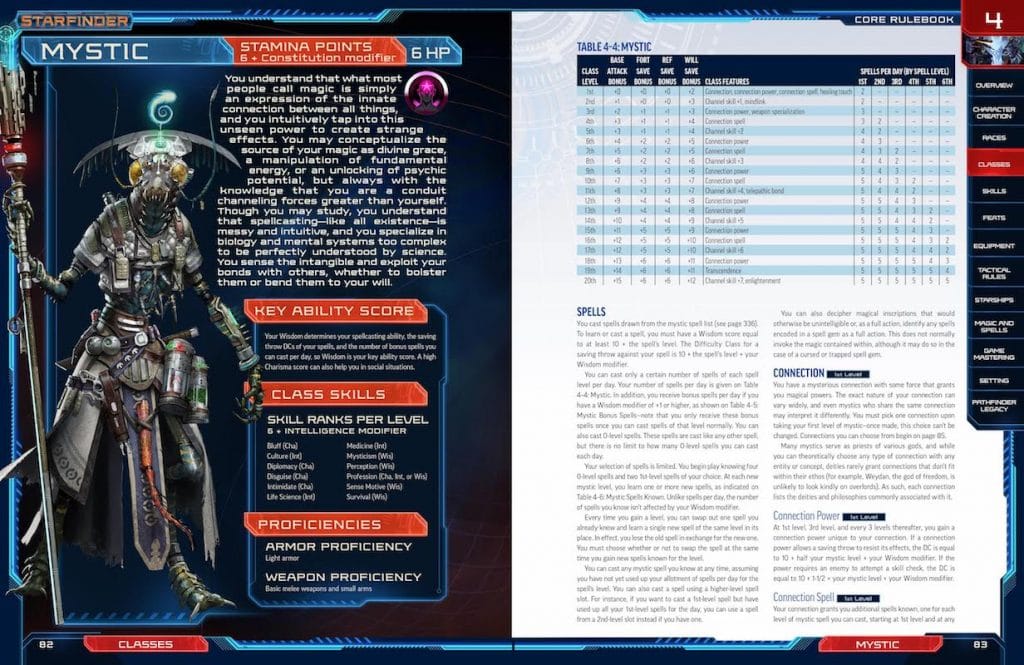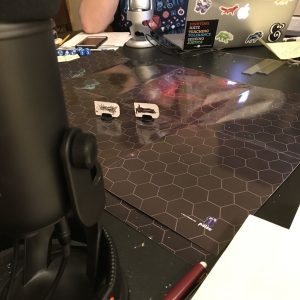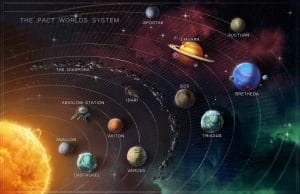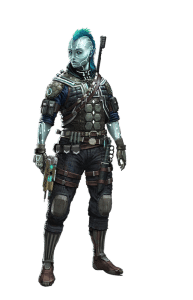Starfinder is a stand-alone roleplaying game evolved from Paizo’s Pathfinder rules that is set thousands of years in Pathfinder’s future and opens up a whole new universe of science-fantasy adventure.
The Starfinder tabletop roleplaying game got its start with a massive 528-page hardcover rulebook that provided the essentials of the Starfinder Roleplaying Game. It includes rules for character creation, lists of gear, a look at planets and settings, and even rules for starship combat. It’s a skull-buster.
James Sutter (the Creative Director for Starfinder) and I first emailed about Starfinder in February of 2017. We released the first episode of The Drift–our podcast dedicated to Starfinder–in April of 2017. Both of these events were well before the August 2017 release of the game’s core rulebook.
I share this because Nerds on Earth has been a hype man for Starfinder, even long before its release. So I have a touch of apprehension in writing this review. What if once I held the game in my hands, it turned out I didn’t like it? Worse, what if we’ve been hyping a game to our readers that turned out to stink? I don’t want to sound hysterical here, but the integrity of Nerds on Earth is on the line when it comes to Starfinder. Needless to say, I wanted to take my time and really consider my thoughts for this review.
Review of the Starfinder Core Rulebook
 Alright, everyone let out a big sigh of relief. Starfinder is awesome.
Alright, everyone let out a big sigh of relief. Starfinder is awesome.
But “Starfinder is awesome” doesn’t cut the mustard as a thoughtful review. I’ll share a partial list of the Starfinder Core rulebook contents, then I’ll discuss further some of the many, many things I think that Paizo did well, plus one area that I think is a miss.
- 7 new alien races, including androids, the telepathic lashunta, lizardy vesk, and more.
- 7 new science-fantasy classes that both serve as analogs to the classic core archetypes in fantasy RPGs, while still managing to take them in creative new directions.
- An overview of Starfinder’s core setting, including the planets of the Pact Worlds, factions, and a pantheon of gods.
- Complete rules for starship combat, as well as rules for building a starship your party uses to travel the Drift.
- Hundreds of weapons, armors, and items, both magical and technological, from laser guns to cybernetic implants.
- Advice on converting Pathfinder RPG content to Starfinder
- Game Master rules and much, much, much more (it is 528 pages, after all).
Review of the Starfinder Core Rulebook
Starfinder is familiar to anyone who has even dabbled in D&D. I’ve heard folks bemoan that Starfinder is too complicated, but I think that is to spend too much time laying in the weeds. Really, pretty much everything is a roll of a d20, then the addition of a couple modifiers. If you have any familiarity with the 40 years of D&D, you can wobble your way into Starfinder in just a few minutes.
Starfinder is Paizo taking all they’ve learned in a decade of perfecting the d20 system. They’ve highlighted what works well and sloughed off the cruft. But the basics haven’t changed.
And Starfinder is slickly and elegantly done as well. The team at Paizo reminded the industry that they are professionals. It’s like they took the ball, stepped a few feet behind the three point line, closed their eyes just to show off, then hit the shot with nothing but net. (My apologies for using a sportsball metaphor on a nerdy website.)

Starfinder is modern and fresh. But don’t think that Starfinder is just a coat of science fiction paint on the same old RPG that has been rolling around for 40 years. It’s not just elves with laser pistols. (Not that there would be anything wrong if it were just that!)
I’ve written before about some big differences between Starfinder and Pathfinder (or D&D), so I’ll just link you to that list. But I want to talk about two of them.
Hit Points are familiar to pretty much anyone. But Starfinder has something called Stamina Points. If a character takes a hit, it comes off Stamina first, as if the character has a certain amount of damage they can brush off and still keep going. But when Stamina is gone, the damage come off of Hit Points, which is serious and more difficult to recover.
It’s not too complex, yet it is more interesting than a flat hit point system. (It reminds me of the optional vigor system from, I think, the Pathfinder Ultimate Combat book.)
Starfinder walks a similar line with armor class. Each character has a EAC (energy) and KAC (kinetic). EAC would protect against something like a plasma blast, while KAC would protect against a sword or punch. Again, it’s not super complex, yet is more interesting that a flat AC system.
Starfinder was created with both care and enthusiasm. It’s clear that a thoughtful approach was taken for Starfinder. The rules nearly always play together nicely. It’s clean and smooth overall.
Sure, the are some places where us nerds will poke, but it is absolutely designed well. Besides, really particular and granular discussion about builds only goes to show how tightly designed a game it is.
But the Starfinder team let themselves have fun as well. There is a two page spread of laser guns that will make you cry tears of joy. And the leveling system for weapons is clever.
They didn’t stop there. Armor fits the science fiction vibe and has upgrade slots to boot. Drones fly around and one class balances the light and dark. Grenades are in the game, as are cybernetics. It’s clear that Team Pazio are science fiction nerds who know how to have a good time.

Ship combat is…not my favorite. Despite being blown away by the game, one aspect let me down. I hate to say it but starship combat broke rule #1 of roleplaying games. It’s a little boring.
Ship combat works on a hex grid, which works overall. But the hex introduces one unfortunate element, which is that the ships aren’t “faceless” in that system. Instead, ships have “sides” and that means you are suddenly having to worry about your aft, starboard, etc. which means working to balance shields and shots according to the side facing the other ship.
To their credit, they worked hard to make sure that all the players around the table had a role in starship combat, meaning it’s not just one player acting as a captain who makes every die roll. The roles like pilot, engineering, etc. mostly work, except, we found, for Wisdom based characters, who really don’t slot well.
Still, that’s picking nits. The main problem is that starship combat plays pretty slow and is overall pretty boring. I wasn’t expecting something as energetic as Fantasy Flight’s X-Wing combat system for Starfinder, but I still wished it had more oomph than it does.
Building starships is awesome! Hey, but there are still starships in the game and that’s pretty great overall. In fact, the rules for creating a starship for the party are pretty much perfect. It’s a joy to start with a frame, then use the everything that’s included in the Core Rulebook to customize it as your own.

The setting is perfect. Another thing that is perfect about the game is the setting itself. Paizo created something magical with their Golarion setting. Golarion is what’s known as a “kitchen sink setting”, meaning it has a little bit of everything for everyone.
The Starfinder setting works very much the same way, yet holds even more untapped potential. Every new planet represents new opportunity. Paizo excels and creating vivid and inviting worlds. Starfinder is another example of Team Paizo showing off that they are top flight nerds, right down to the gorgeous art that takes you on a trip across the universe.
We’re playing Starfinder as one shots. I realize this might not seem significant, but the default setting for Pathfinder is ‘Campaign Mode.’ Known for their fantastic Adventure Paths, Paizo is the best in the business at writing adventures that take a character from level 1 through 15.
This progression understandably leads to a hyper-aware focus on level-by-level advancement for each and every class. (We see this most acutely as nerds arguing about “balance” on message boards.) And this level progression impacts storytelling as well. There is an assumption that characters will follow the long arc of a story, even if that story is broken into manageable scenes (encounters).
 Right now the Nerds on Earth crew (and the vast majority of the brand new Starfinder community) are still kicking the tires of the game via one shots or shorter arcs. It will be years before the progression issue of the game is fully understood, so it would be ridiculous for me to make a judgement on if an 11th level lashunta envoy is .0012% more OP than an 11th level Ysoki technomancer or whatever. (But, let’s be honest, we all know that the sweet spot will be levels 4-9 anyway, am I right?)
Right now the Nerds on Earth crew (and the vast majority of the brand new Starfinder community) are still kicking the tires of the game via one shots or shorter arcs. It will be years before the progression issue of the game is fully understood, so it would be ridiculous for me to make a judgement on if an 11th level lashunta envoy is .0012% more OP than an 11th level Ysoki technomancer or whatever. (But, let’s be honest, we all know that the sweet spot will be levels 4-9 anyway, am I right?)
All I know is we were able to get to playing right away, not even knowing fully how the mechanics worked. And we had an amazing time. Isn’t that what it is about? It will be a while before we’re fully settled into the math and the prerequisite guides appear to fully min/max characters. But I’m confident that Starfinder will score well in those areas. Besides, I don’t care about that. We’re having fun.
I was afraid that I may have hyped up the game in my head to the point that all I could do was be disappointed. But Starfinder gets the highest of marks from me. Paizo stuck the landing with this one and they are only getting started.
[Discloser: Paizo provided Nerds on Earth a copy of the Starfinder Core Rulebook for review.]

